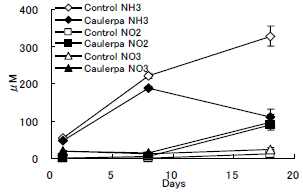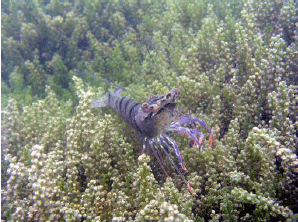Co-culture of Black tiger shrimp (Penaeus monodon) and Sea grapes (Caulerpa lentillifera)
Description
We are attempting to develop co-culture in shrimp farming intended to improve the environment within shrimp ponds by using biofilters. Caulerpa lentillifera, a species of edible seaweed, was chosen for co-culture with Penaeus monodon.
It became obvious that C. lentillifera has high water purification abilities (dissolved nutrient uptake and physical filtration) and it also offers a hiding place for the shrimp.
On the other hand, C. lentillifera is expected to guarantee an alternative income in the event that the P. monodon perish in large numbers, making it possible to prevent the abandonment or neglect of shrimp culture ponds.
The co-culture of P. monodon and C. lentillifera markedly decreased the ammonia nitrogen (by up to approximately 50%), which exerts the most adverse effect on the cultivation of underwater shrimp. We discovered that favorable water quality could be easily maintained over the long term by co-culture with seaweed, since seaweed grows more steadily than phytoplankton. As a result of C. lentillifera utilizing the nutrients dissolving from leftover shrimp feed, chemical fertilizers are not needed for growth of C. lentillifera. The growth of seaweed by this system showed an almost identical value to that grown independently using chemical fertilizers.
Caulerpa lentillifera has the ability to adapt to environments with a salinity of approximately 25~35% and water temperatures between approximately 23~33 ˚C. It was thus thought that C. lentillifera would be a suitable species for shrimp culture ponds where temperature and salinity can readily change. The growth of shrimp is not obstructed by co-cultivation with the C. lentillifera.
Using this co-culture system, the number of bacteria adhering to the gills of the shrimp decreased, and the biomass of bacteria in the water stabilized. It is possible to prevent total annihilation of the shrimp from the normally inescapable yellow head virus (YHV), since 1% of shrimps infected with YHV in several earthen shrimp ponds were observed to survive due to co-culture with C. lentillifera.
When a taste test targeting Thai people was conducted, the unexpected flavor and fragrance of this species of C. lentillifera presented no problems, and the texture was particularly popular. It has the potential to become a popular food throughout Bangkok and subsequently Thailand, and may have a bright future as a secondary means generating income for small-scale shrimp culture farmers.
We believe that seaweed has a potentially large market in Thailand, since it can be utilized as human food, in cosmetic and pharmaceutical products, and for animal feed. Our experiments indicate that some seaweeds are effective in improving the aquatic environment. A further series of experiments will be necessary to choose other organisms, like shellfish, to act as effective biofilters in an integrated system.
Figure, table
-
Changes in ammonia (NH3), nitrite (NO2) and nitrate (NO3) concentration in the water of monoculture and co-culture tanks.
Error bars indicate standard deviation with n = 4. -
A Black Tiger Shrimp that survived mass death by YHV disease in a culture pond where Caulerpa lentillifera grows abundantly.
- Affiliation
-
Japan International Research Center for Agricultural Sciences Fisheries Division
- Classification
-
Technical A
- Term of research
-
FY2005(FY2004~2005)
- Responsible researcher
-
HAMANO Kaoru ( Fisheries Division )
TSUTSUI Isao ( Fisheries Division )
SRISAPOOME Prapansak ( Kasetsart University )
- ほか
- Publication, etc.
-
Hamano,K.,Tsutsui,I. and Srisapoome,P. (2006) The use of seaweed for improving water quality in brackish water shrimp farming ponds and effects on shrimp health. JIRCAS Working Report No.44
Sustainable Production Systems of Aquatic Animals in Brackish Mangrove Areas
Tsutsui,I., Hamano,K. and Srisapoome,P. (2006: Co-culture of shrimp and algae: improvement of water quality. Abstract of The 12th Pacific Congress on Marine Science and Technology
- Japanese PDF
-
2005_seikajouhou_A4_ja_Part17.pdf579.29 KB


